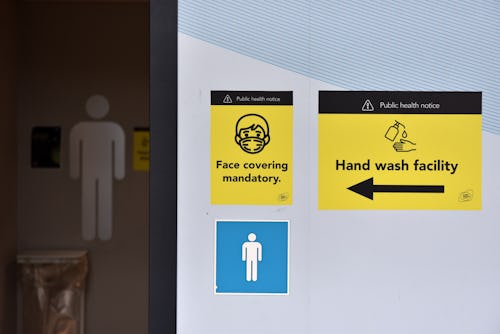Health
Experts Explain How To Make Your Anti-Mask Uncle Care About The Coronavirus Surge
It’s called “COVID caution fatigue.”

There's no getting around it: the current coronavirus surge is scary. But how do you explain the urgency of the situation, and the rise in cases, to somebody who refuses to see the problem? Explaining why you need to take the coronavirus surge seriously to someone who doesn't get it can be really hard.
"This recent surge in cases should be alarming to all," Dr. Robert Quigley M.D., regional medical director of medical security company International SOS, tells Bustle. But it clearly isn't, as many people are still downplaying the virus, or their personal risk, or just won't say no to that pool party. Johns Hopkins University data from July 15 shows that 32 states now have more cases per week than they did in spring, and 20 states just had their worst weeks ever, including Washington, Florida, New Mexico, and Nevada. California has been particularly hard hit, with positive cases rising nearly 50% over the past 14 days.
Experts say there's a psychological reason people are ignoring the coronavirus surges. It's called COVID caution fatigue. Months of social distancing and quarantine have stressed people to their breaking point, and many are tired of socially distancing and staying away from our favorite places. Our brains are really exhausted by being cooped up in a virus-induced hellscape, and want this all to be over. Unfortunately, it's not.
"People seem to be very polarized with it comes to the coronavirus as of late; you’re either taking it seriously or you’re not," therapist Heidi McBain LMFT tells Bustle. Whatever the situation in your individual state, now is the time to tell those around you that it's not cool to have bridal showers, go to a bar, or randomly roll up to the market without a mask on because "it's getting better." But some methods of having this discussion may be more effective than others.
Use Parallels To Make Big Numbers Make Sense
"If you’re worried about the people you love not taking the recent surge seriously, it might help to send them some recent articles or news clips from reliable sources on this topic," McBain says. Dr. Quigley suggests that some of the shocking numbers might be helpful for getting people on side: The number of confirmed cases is now around 3.7 million and rising, according to the Centers of Disease Control & Prevention (CDC) which is more than the entire population of Utah. CDC data says that there have been over 135,000 deaths confirmed as linked to COVID-19 in the U.S — that's already more than the number of Americans who die of strokes annually. Parallels can make big numbers digestible.
Set Aside Time To Talk Privately
If you can, it's a good idea to talk to people one-on-one, McBain says. "Schedule a time to talk about how they are feeling and to share your feelings with them as well," she says. "Unfortunately, we can’t control other people and how they choose to navigate this situation, but we can share our worries and fears with them in hopes that it will lead to behavioral changes." Telling them that you're worried about them, and explaining why, may change their minds.
Make The Conversation About Sharing Responsibility
It may be helpful to frame the situation in terms of responsibility, and how much people now need to depend on one another for safety. "Everyone has a role to play in slowing the spread and protecting themselves, their family, and their community," Dr. Neal Shipley M.D., medical director at Northwell Health-GoHealth Urgent Care, tells Bustle. "There is so much misinformation out there. No one mitigation strategy works well in isolation — so for example, the combination of quarantining those who may have been exposed, wearing face coverings, hand washing, and social distancing will all work better when used together."
...Or Make It All About Them
Appealing to their own self-interest might work, too. "If cities and states reimplement stay-home orders and curfews, we could see a direct impact on our economy," Dr. Quigley says. "Many businesses be forced to re-close and/or close permanently, but our schools/colleges would have to forego admission." Their favorite restaurants and small boutiques might not stand the pressure, and could go under entirely. If they know any doctors or nurses, he says, it could be helpful to tell them about the situation in hospitals and medical centers. "A continued surge in cases also puts an extreme strain on our healthcare infrastructure, which in some jurisdictions is already reaching capacity."
The good news is that we can all do something to stop the spread, and that can be a positive way to frame the surge to other people. "We know that precautions are effective in mitigating the spread of COVID-19 and if strictly followed, can help get us closer to a COVID-19 risk-free environment," Dr. Quigley says. That includes all the guidance we've heard before: washing your hands frequently, wearing an effective mask, and staying six feet away from everybody as much as possible. Various studies show that masks can help reduce transmission by up to 40 to 80%. If we take it seriously now, things will get better in the future. And one day pool parties can be on the menu. Just not right now, Karen.
Experts:
Heidi McBain LMFT
Dr. Robert Quigley M.D.
Dr. Neal Shipley M.D.
This article was originally published on